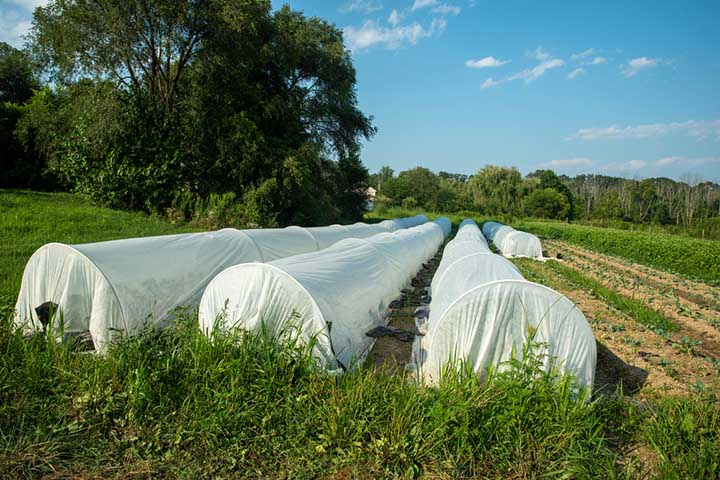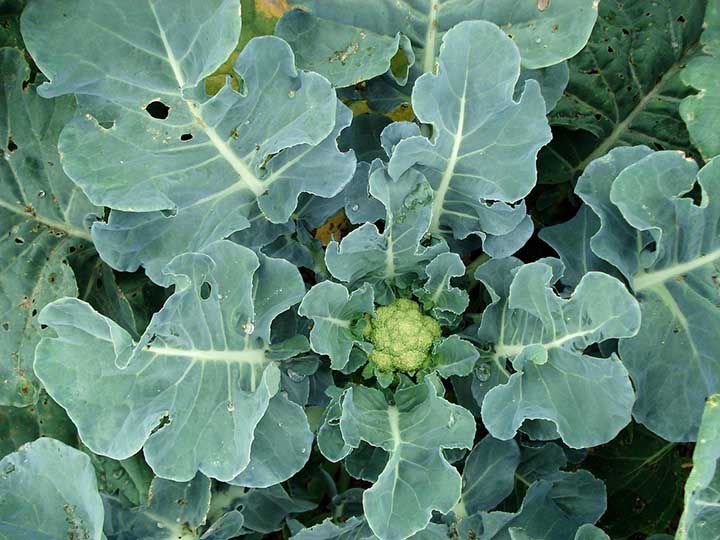Cauliflower is a popular vegetable to grow. However, cauliflower only makes one head per plant. Therefore, if a worm causes severe damage to the plant or head, the head may not grow or may not be good to eat.
There are ways to protect your cauliflower from worms. Prevention is easier than treatment. Read on to learn how to protect your cauliflower.
How to Get Rid of Worms on Cauliflower Plants?
Most worms that bother cauliflower can be killed using Bacillus thuringiensis. Cutworms and cabbage root flies can be eliminated by spreading diatomaceous earth on the soil around cauliflower plants. Most of these pests are the larva of moths. Using row covers to exclude the adults will protect your cauliflower.
Table of Contents
Symptoms of Worms on Cauliflowers
There are several different types of worms that attack cauliflower. Here are the symptoms to look for when growing cauliflower plants.
- Seeing a worm on the plant
- Reduced vigor
- Wilting
- Yellowing plants
- Large irregular holes in the leaves
- Holes bored into the head
- Irregular holes on the underside of the leaf
- The stem of young plants severed at ground level
- Irregular holes in the head
- Skeletonized leaves
Types of Worms on Cauliflower
Knowing which worm is causing problems for your cauliflower will tell you how best to get rid of that pest.
Beet Army Worm (Spodoptera exigua)
This green caterpillar, or worm, will make circular holes in the leaf and will skeletonize the leaf. If too many leaves are eaten, the plant will die. The beet armyworm can go through three to five generations a year. Therefore, they can build up a large population very quickly.
Cabbage Looper (Trichoplusia ni)
Cabbage loopers are pale green with white lines down the side. They move like an inch worm. These pests can also eat all of the leaves on a plant, killing it.
Cutworms (Several species)
Cutworms are grubs that live in the soil during the day and come out to feed at night. They have various colors and patterns, but almost all of them will curl up into a C when disturbed. Cutworms will cut seedlings off at ground level. They will bore into the head and stem of the plant if it is older.
Diamondback Moth Larva (Plutella xylostella)
These green caterpillars feed between the upper and lower surface of the leaf, leaving behind a silvery trail. When older, they eat holes in the leaf. The larva may use a silk thread to rapidly fall to the ground if disturbed.
Large Cabbage White Butterfly larva (Pieris rapae)
A large caterpillar, this worm is green and hairy. There may be faint yellow to orange stripes down the back. The caterpillars tend to be slow-moving, making them easier to catch than other caterpillars. In large numbers, these caterpillars do extensive damage to the plant by eating the leaves.
Cross-Striped Cabbageworms (Evergestis rimosalis)
These worms have black and white stripes and yellow racing stripes down the side. They can rapidly skeletonize a plant.
Cabbage Webworms (Hellula rogatalis)
Cabbage webworms have tan and brown racing stripes and a dark head. They eat buds and the growth points on the stem and stunt the cauliflower plant. Such damage means a head may not form or may be very small.
Cabbage Root Maggots (Delia radicum)
This maggot is the white larva of the cabbage root fly, a tiny fly that lays its eggs in the soil. The larva eats the roots of the cauliflower plant, stunting it.
Preventing Worms on Cauliflower
You can do some things to prevent worms from bothering your cauliflower. Most of them are easy and are probably things you need to do in your garden anyway.

- Place floating row covers over your cauliflower when transplanting the seedlings to your garden. These are white covers placed on half hoops of PVC or other materials and keep the moths and butterflies away from your plants.
- Remove weeds from your garden and the surrounding area to keep insects from overwintering in them.
- Remove plant debris as soon as the plant is done for the season. Doing this avoids feeding the worms and letting their population build up between seasons.
- Hand pick the worms off your cauliflower plants and drop them in a jar of soapy water to kill them.
- Crush eggs you find on your cauliflower. Be sure to look at the underside of the leaf, as that is where many pests lay their eggs.
- Plant sweet alyssum, parsley, dill, cilantro, buckwheat, and fennel around your cauliflower. These plants attract parasitic wasps and flies that kill worms by laying eggs on them.
- Plant marigolds around your plants to reduce root-knot nematodes in the soil.
- Avoid broad-spectrum pesticides as these kill the beneficial insects that feed on the worms.
Getting Rid of Worms on Cauliflower
Using chemicals to control the worms on your cauliflower should be your last resort. However, if all your preventive methods have failed, here are some ways to remove the worms from your cauliflower.
Most worms can be killed with a product containing Bacillus thurengiensis (Bt). Bt is a bacterium that reproduces by spores. It does so by producing toxins that kill some caterpillars and maggots.
Different strains kill different types of insects. They generally do not affect beneficial insects, birds, or animals.
Bt is allowed in organic gardening. It comes in granular, liquid, or dust. You can also use spinosad, another biological pesticide allowed in organic gardening that targets pests but not beneficial insects.
There are several products to choose from. Here are a few products that will work.
Bonide (BND807) – Caterpillar and Worm Killer

Southern Ag 13022 Thuricide BT, Caterpillar Control

Entrust SC Insecticide 1 Quart – Certified OMRI Organic

Cutworms and cabbage root maggots can be controlled by spreading diatomaceous earth around the plant. Diatomaceous earth has sharp edges that pierce the skin of the cutworm and dry it out.
The cabbage root fly will not lay eggs if the diatomaceous earth is on the soil. Get diatomaceous earth for garden use, not for pool use.
You can also use a broader spectrum insecticide to kill these insects, but you risk killing the worms’ natural enemies and other beneficial insects.
If you use broad-spectrum pesticides, apply them in the early evening, so the bees and other beneficials are done feeding for the day. Then, spray only the affected plants.
Frequently Asked Questions
Are cauliflower worms harmful to humans?
Cauliflower worms are not harmful to humans, but they may prevent your cauliflower from producing heads or ruin the flavor of the heads.
Can I eat the worms on my cauliflower head?
While you should not eat the worms if you can help it, eating a worm on your cauliflower head will not make you sick if the worm is cooked.
Do cauliflower worms bite?
No, they cannot bite humans or pets.
Are cauliflower worms toxic to pets?
No, they are not. However, if your pet eats large numbers of them, the pests may upset your pet’s stomach.
Worms can cause problems with your cauliflower by eating the leaves, stems, and heads on the plant. They can also ruin the taste of the heads. You can do many things to keep your cauliflower healthy and worm-free. If you have worms, some products will kill them and are allowed in organic gardens.
